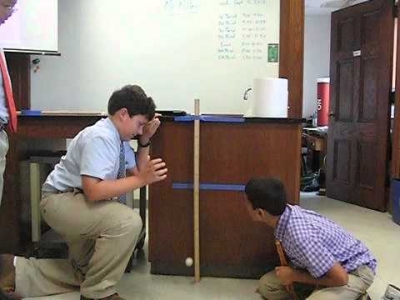
What you need:
- Different bouncy balls (ping pong ball, rubber ball, a marble)
- Modelling clay rolled into a ball
- A friend
- Measuring tape
- A recording sheet
- A wall Sticky tape
What to do:
1. First, discuss with your partner and come up with guesses about which ball will bounce the highest.
2. Next, hold the measuring tape against the wall, starting from the ground to about a 100 cm height (the zero marker should be close to the floor). You can either keep holding the measuring tape or just stick it using transparent sticky tape. Make sure the scale is vertical before sticking
3. Now, start with the rubber ball. Drop it from a pre-decided mark, say 50 cm on the tape. Roughly estimate how high it bounces, using the tape Record it.
4. Take three different readings for the rubber ball and take an average. The average bounce height will be (bounce height 1+ bounce height 2 + bounce height 3)/3.
5. Repeat steps 3 and 4 for each of the other balls, keeping the drop height constant (in this case, 50 cm).
What happens:
According to your average readings, the rubber ball should have bounced the highest, followed closely by the ping pong ball. The marble does not bounce really high and the modelling clay ball is the least bouncy of the lot.
Why?
Each ball has different ‘elasticity’ which affects its bounce. Elasticity is the tendency of a body to return to its original shape after it is stretched or compressed. In this case, the rubber ball has the highest elasticity. When the rubber ball is dropped to the ground, it hits the floor and some of its kinetic energy (or movement energy) is spent when the ball gets compressed. But since the material of the ball is elastic, it quickly returns to its original shape and pushes back against the ground. This gives it an upward springing motion or bounce.
Out of all the balls, the marble is the least elastic.
It does not get compressed on hitting the ground and so, does not bounce back too much.
Modelling clay does not have elasticity: it has plasticity. Plasticity is the quality that allows a material to be easily shaped or moulded. So when the ball of modelling clay is dropped, it does not return to its original shape. Its kinetic energy is spent when it gets squashed. If you touch the clay, you will find it slightly warm to the touch. So part of its kinetic energy is converted to heat while changing its shape.
Picture Credit : Google




